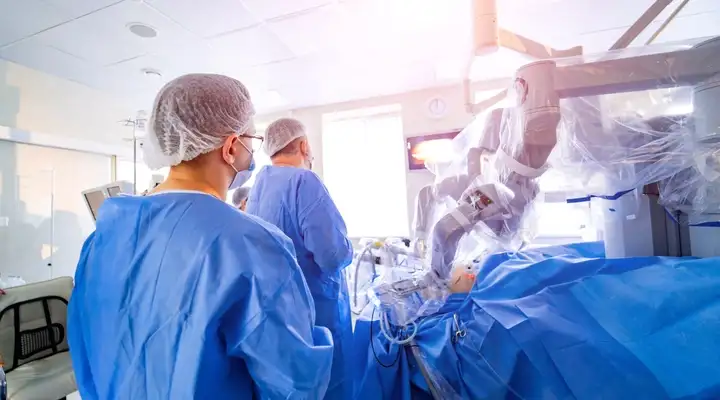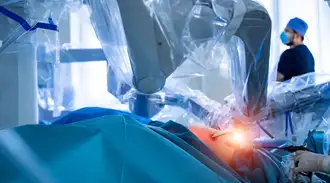
- Home
- Expertise
- Applications
- Minimally invasive surgery
Minimally invasive surgery
Endoscopic, laser and robotic surgery are rapidly developing areas of medicine, turning long and complex operations into less invasive and quicker procedures. Central to these exciting areas are light guides and glass optical fibers, which deliver intense illumination precisely where the surgeon needs it.
Visibility, performance, precision
Accurate and reliable light delivery is vital during minimally invasive surgery. Using a tiny camera or fiber optic image guides, images from inside the body can be transferred to a screen to give the surgeon a complete picture of the area of treatment.Pure white, homogeneous light in visible wavelengths offers intense illumination with a very natural color impression. This light is delivered via glass optical fibers that maintain high transmission over long distances to provide a true-to-life view of human tissue.
With laser light therapy on the rise, there are now a number of applications that require the precise delivery of light in the visible, NIR and UV spectrums to the point of treatment.

1/3
Improving visibility
Endoscopic surgery is performed in an abdominal cavity filled with light-absorbing structures. Delivering bright “natural” white light in the visible spectrum with a high color rendition index is essential for successful visualization.

2/3
Enhanced visualization
Robotic surgery often covers long distances, with light from a remote source needing to reach the patient with no loss of performance. Light in the NIR and UV spectrums offers enhanced vision in applications such as fluorescence imaging.

3/3
Advanced laser light treatments
From treating tumors to dermatology, therapies based on laser light have an important role in patient health. Photo-dynamic and photoimmunotherapy, as well as laser interstitial thermal therapy, are at the forefront of new developments in medicine.
Improving your lighting and imaging design
Illumination system design is a defining factor for image quality, enabling the surgeon to accurately observe the human body in the greatest detail. SCHOTT fully understands the importance of matching the illumination system to the imaging device when developing new endoscopes, robotic visualization optics, and other handheld medical devices.For surgeons, high definition visibility of their actions on a screen is vital, visibility that’s provided by very white and homogenous light delivered into the body. SCHOTT PURAVIS® glass optical fibers are ideal for transporting light from an external light source directly to the patient, offering intense and precise light with a highly natural color.
For light-based therapies, SCHOTT® Luminous Diffusers offer efficient and homogeneous laser light diffusion at the exact point of action, as well as precise heat management.

Monteris Medical: A paradigm shift in minimally invasive neurosurgery
Monteris Medical’s goal is to create a minimally invasive surgical option for use in the brain with a team dedicated to improving the lives of patients affected by epilepsy or brain tumors. Richard Tyc, Vice President, Technology and Advanced Development, has been part of the company’s development since its foundation. He talks about the challenges of intracranial treatment and the importance of clinical evidence.
More information

TeDan Surgical Innovations: Advancing surgical access systems
TeDan Surgical Innovations is a global leader in surgical access systems with a specialty focus in spine, neuro, and cardiothoracic surgery. In this interview, Ed Asturias, Vice President, Business Development, discusses the importance of precise surgical access in minimally invasive procedures, the company’s approach to innovation, and the advantages arising from a multi-cultural perspective.
More information

Gray Optics: Improving optical imaging for minimally invasive surgical procedures
Gray Optics is advancing optical system design and product development for minimally invasive surgical procedures, other critical medical imaging applications and industrial applications. In this interview, founder and CEO Dan Gray talks about designing complex optical systems, the importance of illumination to provide enhanced visualization, and his passion to inspire the youth for optics.
More information

Trice Medical: Advancing minimally-invasive orthopedic diagnostics
Trice Medical’s mission is to provide more immediate and definitive patient care by revolutionizing procedures in the physician’s office. Working to improve orthopedic diagnostics, the company has pioneered fully integrated camera-enabled technologies. CEO and President Mark Foster shares his insights on the future of patient care, improving user experience and the role of optics and visualization.
More information

Activ Surgical: Combining autonomous robotics with traditional medical treatment
Activ Surgical is on a mission to revolutionize surgery by empowering surgeons with real-time intelligence and visualization to achieve the best possible outcomes and save lives.
More information

Titan Medical: Innovative technologies for single access robotic surgery
Titan Medical is on a mission to design and develop surgical technologies for single access robotic surgery. In this interview, Dr. Perry A. Genova, Senior Vice President, Research and Development of Titan Medical Inc., and President of Titan Medical USA Inc., talks about innovations in robotic surgery, the importance of visualization for an immersive experience, and why it takes a great team to be successful.
More information

Erbe Vision: improving imaging systems for minimally invasive surgery
Located in Tuttlingen’s Medical Endoscopy Cluster in Germany, Erbe Vision specializes in minimally invasive surgery. The company is continuously working on new ways to enhance surgical outcomes. Chief Executive Officer Shirish Joshi shares his insights on the potential of fluorescence imaging technologies, augmented reality as an enabler for the surgery of the future, and why innovations in endoscopy need the best light.
More information
Our products for minimally invasive surgery
The latest technology can improve medical device manufacturing, image-based diagnosis, and light-based therapies, helping patients take control of their health.





